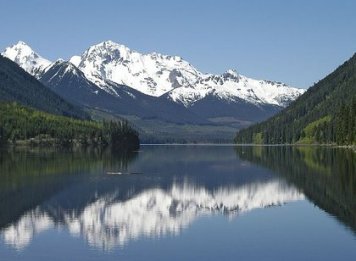
Gold Panning near Whistler? Where?
Gold panning in the Whistler corridor is an interesting activity to do while enjoying your vacation, however if you were to ask most folks, they wouldn’t be able to tell you where to go. So consider this as your guide to a lot of fun. The top photo is Duffy Lake where you will soon visit in this guide.
Gold was discovered on Cayoosh creek, several miles up the creek from the Fraser river at Lillooet back in 1884.
Do you want to try gold prospecting? This is what you will need before you hit the trail.
The area we are talking about is reachable from Whistler by turning north onto highway 99 and driving towards Pemberton. At Pemberton you turn right and drive through the beautiful Mount Currie Reserve area, along the Lillooet river and lake. Turn right onto the Duffy Lake road. It’s about a 45 minute drive to this point from Whistler.
From this intersection you are in for a delightful drive. The gorgeous scenery you have just witnessed continues as you are going to gain some altitude up along this highway. Soon you will pass Joffre Lake. Recreation Area on your right. Another 10 minutes or so you will be in the Duffy Lake valley. Be sure to stop at some of the viewpoints, especially as you arrive at the eastern end. Pull out on the left. The Matier Glacier boldly presents itself at the south end and if you are lucky enough to be here on a calm day with no wind you will be rewarded with beautiful photo opportunities.
Take a look at the $1,000,000 Nugget
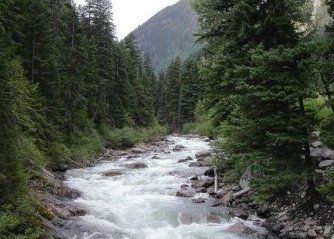
Coyoosh Creek
The outlet at the eastern end is the Cayoosh Creek. It starts its trip to the Fraser river some 25 miles or so very gently. The highway follows along and along the way there are numerous campsites awaiting travelers equipped for tenting or RV travel.
Find Gold with the latest Gold Dredge.
Not too far along the way the creek begins to pick up speed. You don’t really feel it but the land descends gradually. The creek soon becomes a boisterously moving swiftly flowing creek that doesn’t stop until Lillooet.
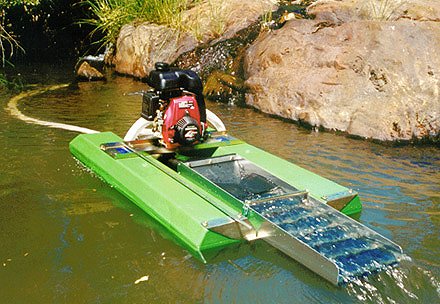
Gold Dredges such as this one are perfect for the small timers. Lightweight, easy to carry, you can transport it to your favorite creek easily. You can use hip boots or waders and the 2 to 6 inch hose and the powerful motor will get you working in the gold nuggets easily.
Gold Nuggets. This is what it's all about.
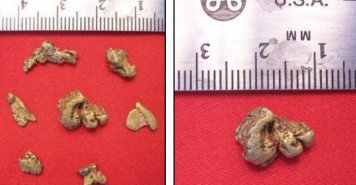
It was along this creek, 7 miles or so from Lillooet that a prospector was gold panning when he found nuggets. News quickly traveled and soon the gold rush of 1884 was on. It is amazing how, not only how fast the news traveled, but how many people were ready to drop what they were doing and head hundreds and even thousands of miles with the dream of striking it rich.
Make Money Hi-Banking for Gold
Come they did though. They would arrive by boat at New Westminster near Vancouver BC. Head up the Fraser River and then up the Harrison river to Harrison Lake. Then up the lake to Lillooet Lake. Now they had to walk overland through the rugged wilderness to Duffy Lake and then follow the Cayoosh creek to the discovery area. They must have been desperate people to have endured that trip.
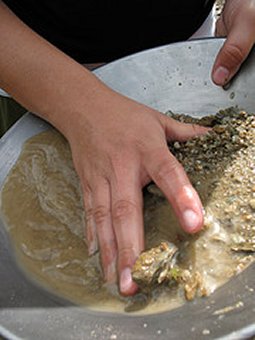 The Chinese were very patient, diligent, deliberate workers. They worked very hard, never laying a rock down without thoroughly cleaning it in the search for the elusive gold flakes and nuggets. The swiftly flowing waters of Cayoosh creek had to be rerouted in order for the miners to work. Then the gravel had to be shoveled into the hoppers of the shaker boxes and then the boxes had to be shaken and rocked back and forth. The more progressive would build sluice boxes to increase the flow of gravel through the box.
The Chinese were very patient, diligent, deliberate workers. They worked very hard, never laying a rock down without thoroughly cleaning it in the search for the elusive gold flakes and nuggets. The swiftly flowing waters of Cayoosh creek had to be rerouted in order for the miners to work. Then the gravel had to be shoveled into the hoppers of the shaker boxes and then the boxes had to be shaken and rocked back and forth. The more progressive would build sluice boxes to increase the flow of gravel through the box.
Sluice Box Prospecting. A Very Profitable Hobby
Eventually the box would be cleaned along the riffles and the gold that had gathered would be saved. This was at a time when gold was priced at $16.00 per ounce. Now it is close to $1,000. per ounce. The creek today is as wild as it was then. It roars through the canyon at a high rate of speed. You can pan for gold along the creek but nothing of a mechanical nature such as rockers or sluices are allowed to be used.
Very old photo of Chineese miners at Coyoosh Creek
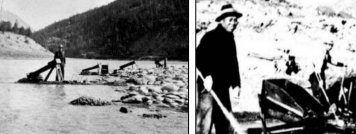
Once the gravel was cleaned, the Chinese workers would put it through the sluice the second time in case any little flake was missed. The gravel would be taken away for a distance to make way for more. Even today those gravel banks may be seen where they were placed so many years ago. The same system was enacted with the rocks and boulders. Back breaking work.
In the meantime the prospectors who were arriving in the area had to branch out and find more territories to seek their fortune via gold panning. They worked the creeks around Seton and Anderson Lakes where they made some profitable claims. Finally this activity led to the discovery of the very rich Bridge River goldfield.
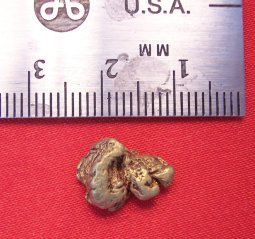 Gold is dispersed within rock. That rock is acted upon by nature and over long periods of time the flakes and nuggets erode out of the rock and being heavier than other minerals, works it’s way to the bottom of the rivers and streams. As it moves and tumbles along in the water it bumps into gravel and rocks and being softer than the rocks themselves. Notice how the edges of the nuggets have worn down and become rounded. Tiny flakes break off. Experienced gold panning miners know how far away upstream the gold they find has traveled.
Gold is dispersed within rock. That rock is acted upon by nature and over long periods of time the flakes and nuggets erode out of the rock and being heavier than other minerals, works it’s way to the bottom of the rivers and streams. As it moves and tumbles along in the water it bumps into gravel and rocks and being softer than the rocks themselves. Notice how the edges of the nuggets have worn down and become rounded. Tiny flakes break off. Experienced gold panning miners know how far away upstream the gold they find has traveled.
The gold flakes found in the Fraser river were tiny and therefore prompted prospectors to carry out gold panning further and further upstream. This led to the rich finds in the Barkerville area where millions of dollars worth of gold was found as a result of gold panning prospecting.
Cayoosh gold was all nugget size. Ranging from $1.00 to $100.00 in value. This was amazing as gold at that time was valued at $16.00 per ounce. The Chinese workers dug down to 14 feet in some instances, removing the gravel to get at the gold which would be on the bedrock on the bottom of the stream.
The gold nuggets appeared to come from the area about 6 miles above the falls as stated above.
The Golden Cache Mine
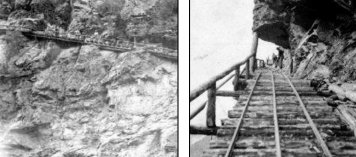
This led to explorations of the area and led to the opening of the Golden Cache Mine at this point. Take a careful look at these photos. The mine vein was located high up on the cliff face. My question would be, to what lengths would a prospector go to find gold? Since the cliff was solid rock and the cliff face was vertical, the miners devised this sort of a tramway to get the pay dirt down to the bottom level.
Here is a look at the tramway, end on. What did they have to stand on while building this? Some of the cliffs in the canyon are more than 5000 feet high. Straight up.
The gold panning miners had to face other problems as well. Winter snows would bring avalanches due to the steep, mountainous area. Summer heat in this area usually scores as the highest in Canada.
The mine went broke after a fair quantity of gold was recovered. Money had been raised on the selling of stocks and all was lost as the mine never broke even.
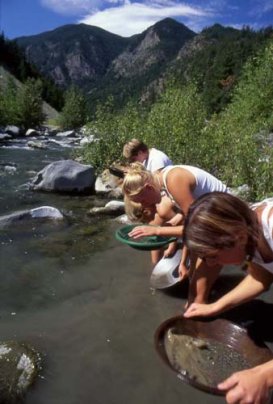
After the gold was cleaned out of Coyoosh creek and the Fraser river many of the Chinese stayed on in the Lillooet area and opened businesses. As well many went into market gardening and supported themselves and their families by exporting their produce. Lillooet had it’s Chinatown for many years.
Today a few businesses operate in Lillooet offering gold panning. It is a great way to spend the day getting to know just how tough it must have been for the miners of yesteryear. Of course they didn’t have paved roads or swift transportation to get them about.
If you have a day of your vacation remaining and want to try something really exciting and different in a fantastic setting, do this trip. You will not be disappointed.
Eccentric millionaire built an underground compound on Cayoosh Creek in case of nuclear war.
Return from Gold Panning to Whistler Outdoors



